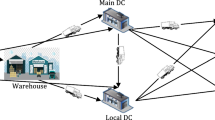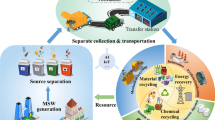Abstract
Long-term block scheduling is a challenging problem that involves determining the best extraction period for blocks to maximize the net present value of the open-pit mining business. This process involves multiple constraints, mainly ensuring safe pit walls and imposing maximum limits on operational resource consumption. However, most of the models proposed in the literature do not sufficiently consider geometric constraints that ensure a minimum space for mining equipment to operate safely. These models overlook practical and operational constraints and generate solutions that are difficult to implement. Consequently, the promised net present value cannot be achieved. In this paper, we propose an integer linear programming model that considers minimum mining width requirements along with a decomposition heuristic method to solve it.The proposed model determines which blocks should be mined and when to maximize net present value while ensuring safe pit walls and respecting limits on operational resources and geometric constraints. Geometric constraints require that the minimum operational distance be considered within each extraction period. Because the incorporation of geometric constraints in the proposed model makes it harder to solve, a time-space decomposition heuristic is implemented. This heuristic consists of successive time and space aggregation/disaggregation to generate simpler subproblems to be solved. This approach was applied on two case studies. The results show that the proposed methodology generates practical production plans that are more realistic to implement in mining operations, lowering the gap between factual and promised net present value.












Similar content being viewed by others
Abbreviations
- AGCPIT:
-
Aggregated geometric constrained pit limit problem
- CPIT:
-
Constrained pit limit problem
- DBS:
-
Direct block scheduling
- GCPIT:
-
Geometric constrained pit limit problem
- LG:
-
Lerchs & Grossmann (algorithm)
- NPV:
-
Net present value
- PCPSP:
-
Precedence constrained production scheduling problem
- STDH:
-
Space and time decomposition heuristic
- UPIT:
-
Ultimate pit limit problem
References
Aalian Y, Mousavi A, Bsiri MH (2022) A new mathematical model for the optimization of block aggregation in open pit mines. Mining Technology, pp 1–10
Askari-Nasab H, Pourrahimian Y, Ben-Awuah E, Kalantari S (2011) Mixed integer linear programming formulations for open pit production scheduling. J Min Sci 47(3):338–359
Bai X, Marcotte D, Gamache M, Gregory D, Lapworth A (2018) Automatic generation of feasible mining pushbacks for open pit strategic planning. J S Afr Inst Min Metall 118(5):515–530
Bienstock D, Zuckerberg M (2009) A new LP algorithm for precedence constrained production scheduling. Optimization. Online Accessed 29 Aug 2022. http://www.optimization-online.org/DB_FILE/2009/08/2380.pdf
Bienstock D, Zuckerberg M (2010) Solving LP relaxations of large-scale precedence constrained problems. In: IPCO, pp 1–14, https://doi.org/10.1007/978-3-642-13036-6_1
Bley A, Boland N, Fricke C, Froyland G (2010) A strengthened formulation and cutting planes for the open pit mine production scheduling problem. Comput Oper Res 37(9):1641–1647. https://doi.org/10.1016/j.cor.2009.12.008
Boland N, Dumitrescu I, Froyland G, Gleixner A (2009) Lp-based disaggregation approaches to solving the open pit mining production scheduling problem with block processing selectivity. Comput Oper Res 36(4):1064–1089. https://doi.org/10.1016/j.cor.2007.12.006
Caccetta L, Hill S (2003) An application of branch and cut to open-pit mine scheduling. J Glob Optim 27:349–365. https://doi.org/10.1023/A:1024835022186
Chicoisne R, Espinoza D, Goycoolea M, Moreno E, Rubio E (2012) A new algorithm for the open-pit mine production scheduling problem. Oper Res 60(3):517–528. https://doi.org/10.1287/opre.1120.1050
Cullenbine C, Wood R, Newman A (2011) A sliding time window heuristic for open pit mine block sequencing. Optim Lett 5(3):365–377. https://doi.org/10.1007/s11590-011-0306-2
Dagdelen K, Akaike A (1999) A strategic production scheduling method for an open pit mine. In: Dardano C, Francisco JPM (eds)Proceedings of the 28th International Symposium on the Application of Computers and Operations Research in the Mineral Industry (APCOM). Sympos, SME, Littleton, CO, pp 729–738
Dagdelen K, Johnson T (1986) Optimum open pit mine production scheduling by lagrangian parameterization. In: Proceedings of the 19th International Symposium on the Application of Computers and Operations Research in the Mineral Industry (APCOM), SME, Littleton, CO, pp 127–141
Delphos (2022) Minelink MPL. http://delphos.dmi.uchile.cl. Accessed 29 Aug 2022
Deutsch M (2019) Open-pit mine optimization with maximum satisfiability. Min Metall Explor 36(4):757–764
Deutsch M, Dagdelen K, Johnson T (2022) An open-source program for efficiently computing ultimate pit limits: Mineflow. Nat Resour Res 31:1175–1187. https://doi.org/10.1007/s11053-022-10035-w
Dimitrakopoulos R, Ramazan S (2004) Uncertainty based production scheduling in open pit mining. SME Trans 316:106–112
Espinoza D, Goycoolea M, Moreno E, Newman A (2013) Minelib: a library of open pit mining problems. Ann Oper Res 206(1):93–114. https://doi.org/10.1007/s10479-012-1258-3
Fathollahzadeh K, Asad MWA, Mardaneh E, Cigla M (2021) Review of solution methodologies for open pit mine production scheduling problem. Int J Min Reclam Environ 35(8):564–599
Gemcom (2022) Gemcom Whittle™ Strategic Mine Planning software. http://www.gemcomsoftware.com/products/whittle. Accessed 18 May 2022
Gershon M (1983) Optimal mine production scheduling: Evaluation of large scale mathematical programming approaches. Int J Min Eng 1(4):315–329. https://doi.org/10.1007/BF00881548
Gershon M (1987) Heuristic approaches for mine planning and production scheduling. Int J Min Geol Eng 5(1):1–13. https://doi.org/10.1007/BF01553529
Gholamnejad J, Lotfian R, Kasmaeeyazdi S (2020) A practical, long-term production scheduling model in open pit mines using integer linear programming. J South Afr Inst Min Metall 120(12):665–670
Gurobi (2019) Gurobi™ Gurobi Optimization. http://www.gurobi.com. Accessed 20 Dec 2019
Hochbaum DS (2008) The pseudoflow algorithm: a new algorithm for the maximum-flow problem. Oper Res 56:992–1009. https://doi.org/10.1287/opre.1080.0524
Hochbaum DS, Chen A (2000) Performance analysis and best implementations of old and new algorithms for the open-pit mining problem. Oper Res 48:894–914. https://doi.org/10.1287/opre.48.6.894.12392
Hochbaum DS, Orlin JB (2012) Simplifications and speedups of the pseudoflow algorithm. Networks 61:40–57. https://doi.org/10.1002/net.21467
Jélvez E, Morales N, Nancel-Penard P, Peypouquet J, Reyes P (2016) Aggregation heuristic for the open-pit block scheduling problem. Eur J Oper Res 249(3):1169–1177. https://doi.org/10.1016/j.ejor.2015.10.044
Jélvez E, Morales N, Askari-Nasab H (2020) A new model for automated pushback selection. Comput Oper Res 115:104456. https://doi.org/10.1016/j.cor.2018.04.015
Jélvez E, Morales N, Nancel-Penard P, Cornillier F (2020) A new hybrid heuristic algorithm for the precedence constrained production scheduling problem: A mining application. Omega 94:102046. https://doi.org/10.1016/j.omega.2019.03.004
Jélvez E, Morales N, Nancel-Penard P (2019) Open-pit mine production scheduling: Improvements to minelib library problems. In: Proceedings of the 27th International Symposium on Mine Planning and Equipment Selection-MPES 2018, Springer, pp 223–232, https://doi.org/10.1007/978-3-319-99220-4_18
Johnson T (1968) Optimum open-pit mine production scheduling. PhD thesis, Operations Research Department, University of California, Berkeley
Johnson T (1969) Optimum open-pit mine production scheduling. In: 8th International Symposium on Computers and Operations research, pp 539–562
Lambert W, Brickey A, Newman A, Eurek K (2014) Open-pit block-sequencing formulations: a tutorial. J Appl Anal 44(2):127–142. https://doi.org/10.1007/s10479-012-1287-y
Lambert W, Newman A (2013) Tailored lagrangian relaxation for the open pit block sequencing problem. Ann Oper Res. https://doi.org/10.1007/s10479-012-1287-y
Lamghari A, Dimitrakopoulos R, Ferland JA (2014) A hybrid method based on linear programming and variable neighborhood descent for scheduling production in open-pit mines. J Glob Optim 63(3):555–582. https://doi.org/10.1007/s10898-014-0185-z
Lerchs H, Grossman H (1965) Optimal design of open-pit mines. Trans CIM 58:47–54
Letelier O, Espinoza D, Goycoolea M, Moreno E, Muñoz G (2020) Production scheduling for strategic open pit mine planning: a mixed-integer programming approach. Oper Res 5(68):1425–1444. https://doi.org/10.1287/opre.2019.1965
Liu S, Kozan E (2016) New graph-based algorithm to efficiently solve large scale open pit mining optimization problems. Expert Syst Appl 43:59–65. https://doi.org/10.1016/j.eswa.2015.08.044
Meagher C, Dimitrakopoulos R, Avis D (2014) Optimized open pit mine design, pushbacks and the gap problem-a review. J Min Sci 50(3):508–526. https://doi.org/10.1134/S1062739114030132
MineLib (2023) Minelib. https://mansci-web.uai.cl/minelib. Accessed 3 Nov 2023
Morales N, Nancel-Penard P, Espejo N (2023) Development and analysis of a methodology to generate operational open-pit mine ramp designs automatically. Optim Eng 24(2):711–741. https://doi.org/10.1007/s11081-021-09702-3
Morales N, Nelis G, Amaya J (2023) An efficient method for optimizing nested open pits with operational bottom space. Int Trans Oper Res. https://doi.org/10.1111/itor.13390
Moreno E, Espinoza D, Goycoolea M (2010) Large-scale multi-period precedence constrained knapsack problem: A mining application. Electron Not Discrete Math 36:407–414. https://doi.org/10.1016/j.endm.2010.05.052
Muñoz G, Espinoza D, Goycoolea M, Moreno E, Queyranne M, Letelier OR (2018) A study of the Bienstock–Zuckerberg algorithm: applications in mining and resource constrained project scheduling. Comput Optim Appl 69(2):501–534
Nancel-Penard P, Morales N (2022) Optimizing pushback design considering minimum mining width for open pit strategic planning. Eng Optim 54(9):1494–1508. https://doi.org/10.1080/0305215X.2021.1941919
Nancel-Penard P, Morales N, Cornillier F (2022) A recursive time aggregation-disaggregation heuristic for the multidimensional and multiperiod precedence-constrained knapsack problem: an application to the open-pit mine block sequencing problem. Eur J Oper Res 303(3):1088–1099. https://doi.org/10.1016/j.ejor.2022.04.005
Nancel-Penard P, Parra A, Morales N, Díaz C, Widzyk-Capehart E (2019) Value-optimal design of ramps in open pit mining. Arch Min Sci 64(No 2):399–413. https://doi.org/10.24425/ams.2019.128691
Newman A, Rubio E, Caro R, Weintraub A, Eurek K (2010) A review of operations research in mine planning. Interfaces 40(3):222–245. https://doi.org/10.1287/inte.1090.0492
Osanloo M, Gholamnejad J, Karimi B (2008) Long-term open pit mine production planning: a review of models and algorithms. Int J Min Reclam Environ 22(1):3–35
Ramazan S (2007) The new fundamental tree algorithm for production scheduling of open pit mines. Eur J Oper Res 177(2):1153–1166
Saavedra-Rosas J, Jelvez E, Amaya J, Morales N (2016) Optimizing open-pit block scheduling with exposed ore reserve. J South Afr Inst Min Metall 116(7):655–662
Samavati M, Essam D, Nehring M, Sarker R (2017) A local branching heuristic for the open pit mine production scheduling problem. Eur J Oper Res 257(1):261–271
Samavati M, Essam D, Nehring M, Sarker R (2017) A methodology for the large-scale multi-period precedence-constrained knapsack problem: an application in the mining industry. Int J Prod Econ 193:12–20. https://doi.org/10.1016/j.ijpe.2017.06.025
Samavati M, Essam D, Nehring M, Sarker R (2018) A new methodology for the open-pit mine production scheduling problem. Omega 81:169–182. https://doi.org/10.1016/j.omega.2017.10.008
Tabesh M, Askari-Nasab H (2019) Clustering mining blocks in presence of geological uncertainty. Min Technol 128(3):162–176
Tabesh M, Mieth C, Askari Nasab H (2014) A multi-step approach to long-term open-pit production planning. Int J Min Miner Eng 5(4):273–298. https://doi.org/10.1504/IJMME.2014.066577
Vossen T, Wood R, Newman A (2016) Hierarchical benders decomposition for open-pit mine block sequencingt. Oper Res 64(4):771–793. https://doi.org/10.1287/opre.2016.1516
Yarmuch J, Brazil M, Rubinstein H, Thomas DA (2021) A model for open-pit pushback design with operational constraints. Optim Eng. https://doi.org/10.1007/s11081-021-09699-9
Zeng L, Liu S, Kozan E, Corry P, Masoud M (2021) A comprehensive interdisciplinary review of mine supply chain management. Resour Policy 74:102274. https://doi.org/10.1016/j.resourpol.2021.102274
Acknowledgements
We would like to express sincere thanks to Nick Sahinidis and the two anonymous reviewers whose comments/suggestions helped improve and clarify this manuscript.
Author information
Authors and Affiliations
Corresponding author
Additional information
Publisher's Note
Springer Nature remains neutral with regard to jurisdictional claims in published maps and institutional affiliations.
This research has been funded by the Chilean National Research and Development Agency ANID through the programs PIA/Basal Grants AFB180004 and AFB220002 (P.NP. and E.J.) and FONDECYT Iniciación Grant 11221352 (E.J.).
Rights and permissions
Springer Nature or its licensor (e.g. a society or other partner) holds exclusive rights to this article under a publishing agreement with the author(s) or other rightsholder(s); author self-archiving of the accepted manuscript version of this article is solely governed by the terms of such publishing agreement and applicable law.
About this article
Cite this article
Nancel-Penard, P., Jelvez, E. A direct block scheduling model considering operational space requirement for strategic open-pit mine production planning. Optim Eng (2023). https://doi.org/10.1007/s11081-023-09875-z
Received:
Revised:
Accepted:
Published:
DOI: https://doi.org/10.1007/s11081-023-09875-z




